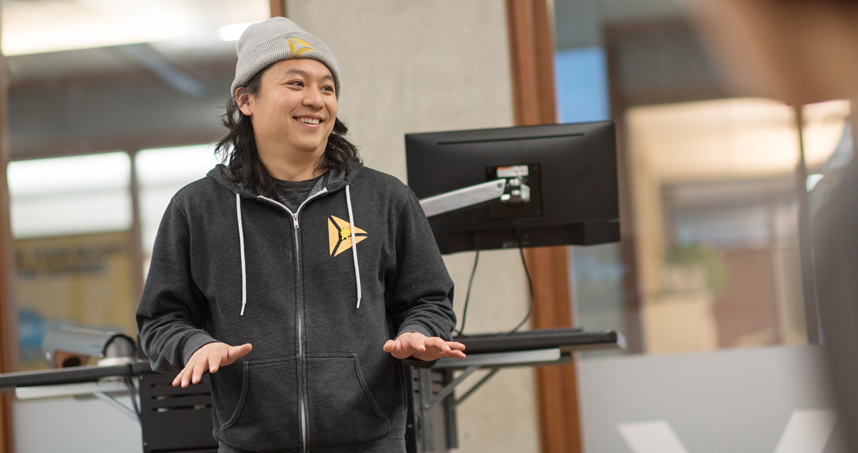Empowering Undergraduates at the Intersection of Design and Computer Science
The Design, Technology, and Research course offers novel research experiences to undergraduates
At the premier conference in human-computer interaction (HCI), the ACM CHI Conference on Human Factors in Computing Systems held in April 2018, two pairs of Northwestern undergraduates claimed the top prizes in the conference’s annual student research competition.
Josh Shi and Armaan Shah introduced a collaborative game that teaches students to plan out solutions to problems they may encounter while learning to code, a step that novice programmers often overlook. Jennie Werner and Allison Sun unveiled a platform for promoting opportunistic interactions among distant family and friends, an offering that fills the space between social media feeds and on-demand communication tools like FaceTime.
The students’ achievement marked another win for Professor Haoqi Zhang and his EECS 315/497: Design, Technology, and Research course, offered through the Department of Electrical Engineering and Computer Science and the Segal Design Institute. Since Zhang created the course four years ago, it has become a compelling research model for others to follow.
“We’ve built a vibrant and special community here of intelligent, motivated, and collaborative students using design research to address complex problems related to people and technology,” said Zhang, the Allen K. and Johnnie Cordell Breed Junior Professor of Design and assistant professor of computer science.
Creating a unique undergraduate computer science experience
Soon after arriving at Northwestern in 2013, Zhang reached out to undergraduate students for help kickstarting research ideas. Within a year, Zhang, who designs, builds, and studies computational ecosystems that unite people and machines to solve complex problems, had some 20 students tackling more than a dozen different projects in his lab.
By empowering his undergraduates to lead independent research projects around new social-computing systems, Zhang enabled his students to work more like early-stage PhD students, a reality that simultaneously propelled Zhang’s research work and the students’ intellectual growth.
But by using academia’s traditional one-to-one mentoring model, Zhang struggled to devote the time and energy necessary to each individual on his growing roster of undergraduate researchers.
Over the next year, Zhang developed a community-based, collaborative research training process he called Agile Research Studios and then brought it in to the now-hallmark Design, Technology, and Research course.
Using fast-paced design process to iterate solutions
In the fast-paced, quarter-long course, students work with Zhang and co-lead Eleanor O’Rourke, the June and Donald Brewer Junior Professor of Computer Science and Learning Sciences, to select specific research directions.
Thereafter, students explore and iterate designs, build prototypes, conduct user studies, test key hypotheses, analyze collected data, and review existing research, a multi-layered effort designed to drive student ownership of research and fuel the development of their own research expertise.
Through scrums, studio critiques, sprints, and design logs, students evolve plans and learn how to handle inevitable struggles. At the completion of each quarter, students also complete a self-reflection in which they consider their personal growth as well as more effective processes and strategies they can bring to their work.
Teaching students how to set goals, measure progress
“Beyond providing students specific research skills, we’re helping them with their personal development and growth,” Zhang said. “We’re using research to teach self-direction, how to set complex goals, work with difficulty, and progress toward results, which are unquestionably valuable skills in today’s world.”
 Students often repeat the course several times. From one quarter to the next, the students’ research grows more focused. They move from building a functioning prototype to conducting a small-scale study to constructing a scalable, deployable system to overseeing larger user studies — and they do it all while navigating technical challenges, the research process, and their own scholarly development.
Students often repeat the course several times. From one quarter to the next, the students’ research grows more focused. They move from building a functioning prototype to conducting a small-scale study to constructing a scalable, deployable system to overseeing larger user studies — and they do it all while navigating technical challenges, the research process, and their own scholarly development.
The students — 63 of them leading 34 distinct research projects over the last four years — pursue their work in a collaborative community. They regularly — and formally — connect with their fellow undergraduates, faculty, and graduate student mentors to receive help examining their approach, confronting obstacles, and strategizing next steps.
“This allows us to use distributed expertise among the entire community,” Zhang said.
A new model for nurturing undergraduate research projects
While undergraduates in the traditional research model sit at the bottom of a hierarchal structure, often struggling to understand how their efforts translate into a greater whole, undergraduates in this course work independently at the intersection of HCI, social and crowd computing, learning science, artificial intelligence, and design.
“Our students deeply understand their research projects because they’ve taken ownership of the process and are working on the core problems themselves,” O’Rourke said.
More than 30 students have landed undergraduate research grants, while students have also published 13 papers and extended abstracts and notched six research competition prizes. In addition, research from the course has resulted in five different National Science Foundation grants.
“That’s not so common among undergraduates, but our group is doing it successfully,” Zhang said.
Teaching the model to peer universities
That success has sparked a steady stream of attention from peers interested in the course’s novel framework and its Agile Research Studios method for training. Zhang, who founded Agile Research University last year to help others advance research training at scale, and O’Rourke have already hosted faculty from institutions such as MIT, Michigan, UC-Berkeley, New York University, and Virginia Tech on the Northwestern campus to showcase the Agile Research Studios method in action.
“To train this many students and have maximum impact, you need processes and methods in place to bring this to scale. That’s what we’ve effectively done,” Zhang said. “That’s changed the experience for our students and opened up a world of new possibilities.”
